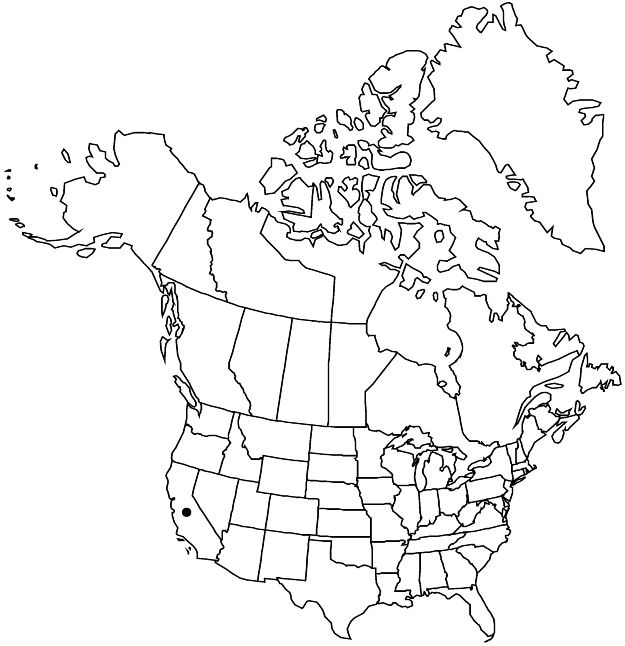Difference between revisions of "Crocanthemum suffrutescens"
Phytologia 93: 271. 2011.
FNA>Volume Importer |
FNA>Volume Importer |
||
| Line 31: | Line 31: | ||
|elevation=100–700 m | |elevation=100–700 m | ||
|distribution=Calif. | |distribution=Calif. | ||
| − | |discussion=<p>Crocanthemum suffrutescens is known from Amador and Calaveras counties, where it is often associated with Arctostaphylos myrtifolia, grasses, and shrub oaks. The remarkable soils of the Ione Formation harbor other localized endemics, including A. myrtifolia, Eriogonum apricum, and Horkelia parryi.</p><!-- | + | |discussion=<p><i>Crocanthemum suffrutescens</i> is known from Amador and Calaveras counties, where it is often associated with <i>Arctostaphylos myrtifolia</i>, grasses, and shrub oaks. The remarkable soils of the Ione Formation harbor other localized endemics, including <i>A. myrtifolia</i>, <i>Eriogonum apricum</i>, and <i>Horkelia parryi</i>.</p><!-- |
| − | --><p>Crocanthemum suffrutescens is similar to C. aldersonii in its tall habit, paniculate inflorescence, and long sepals; it differs in its denser stellate tomentum, shorter and straight inflorescence branches, smaller corollas, and thickened bases to the stellate hairs of the calyx. Leaves of C. suffrutescens tend to persist through summer; they tend to drop in C. aldersonii and C. scoparium; these are tendencies only and cannot be relied on for identification.</p> | + | --><p><i>Crocanthemum suffrutescens</i> is similar to <i>C. aldersonii</i> in its tall habit, paniculate inflorescence, and long sepals; it differs in its denser stellate tomentum, shorter and straight inflorescence branches, smaller corollas, and thickened bases to the stellate hairs of the calyx. Leaves of <i>C. suffrutescens</i> tend to persist through summer; they tend to drop in <i>C. aldersonii</i> and <i>C. scoparium</i>; these are tendencies only and cannot be relied on for identification.</p> |
|tables= | |tables= | ||
|references= | |references= | ||
| Line 56: | Line 56: | ||
|publication year=2011 | |publication year=2011 | ||
|special status=Endemic | |special status=Endemic | ||
| − | |source xml=https://jpend@bitbucket.org/aafc-mbb/fna-data-curation.git/src/ | + | |source xml=https://jpend@bitbucket.org/aafc-mbb/fna-data-curation.git/src/8f726806613d60c220dc4493de13607dd3150896/coarse_grained_fna_xml/V6/V6_774.xml |
|genus=Crocanthemum | |genus=Crocanthemum | ||
|species=Crocanthemum suffrutescens | |species=Crocanthemum suffrutescens | ||
Revision as of 18:50, 18 September 2019
Subshrubs. Stems erect, 35–80 cm, usually stellate-pannose, sometimes sparsely stellate-pubescent. Leaves cauline, tending to persist in summer; petiole 0–1 mm; blade linear to lanceolate, 10–30(–43) × 2–8 mm, surfaces stellate-pannose, lateral veins obscure abaxially. Inflorescences terminal, narrow panicles, usually stellate-pannose, sometimes sparsely stellate-pubescent; chasmogamous flowers 8–20 per panicle, cleistogamous 0. Pedicels 1–9 mm, sparsely or not glandular-hairy; bracts 5–25 × 0.3 mm. Chasmogamous flowers: outer sepals linear, 2 × 0.2 mm, inner sepals 5–7(–8) × 2.5–3.5 mm, apex acute to acuminate; calyx stellate-pubescent, hairs to 1 mm; petals obovate, 6–9 × 5–7 mm; capsules 3.5–4.3 × 2.5–2.7 mm, glabrous.
Phenology: Flowering Apr–Jun.
Habitat: Xeric to dry chaparral in shallow soil of Ione Formation
Elevation: 100–700 m
Discussion
Crocanthemum suffrutescens is known from Amador and Calaveras counties, where it is often associated with Arctostaphylos myrtifolia, grasses, and shrub oaks. The remarkable soils of the Ione Formation harbor other localized endemics, including A. myrtifolia, Eriogonum apricum, and Horkelia parryi.
Crocanthemum suffrutescens is similar to C. aldersonii in its tall habit, paniculate inflorescence, and long sepals; it differs in its denser stellate tomentum, shorter and straight inflorescence branches, smaller corollas, and thickened bases to the stellate hairs of the calyx. Leaves of C. suffrutescens tend to persist through summer; they tend to drop in C. aldersonii and C. scoparium; these are tendencies only and cannot be relied on for identification.
Selected References
None.
